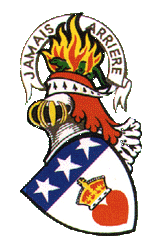When searching through records or gravestones in
Scotland, it is common to find a person described either 'of', a place
or 'in' a place or 'at' a place. These words are of considerable
importance and are still in legal use in Scotland.
When a person is described as being 'of' a place, this means that the
person is the owner of the property, does not pay a feu duty to anybody,
and in fact is the feudal superior of that property. Not long ago there
was a spate of small land owners and farmers who had acquired their own
property, and in Scotland were entitled to be called Barons. This led to
the familiar term of the cloth cap Barons. If a person owns their land
in Scotland, it means that they, as owners will be recorded in the
Sasine Records of Scotland, and gives another source of infomation for
the searcher.
If a person is described as being 'in' property, this a means that this
person is a tenant to a feudal superior and is not the owner of the
property. This can be misleading as sometimes persons 'in' a place have
quite vast estates but of course are tenants because they are renting
their estate from a feudal superior.
When a person is described as being 'at' a place, this means he could be
a lodger to a tenant, perhaps renting some property from the tenant, or
even being exactly a lodger in someone else's property.
Ministers were usually very important persons in their parish, but
correctly they were described as being 'at' a parish because they did
not own it, they did not pay a rent, but were given the Manse and Glebe
to live in by the superior in early days and later by the Kirk Session
of the particular parish.
Norman Douglas of Dundarroch
Of the Ilk
"Of that Ilk" is a term used in the Scottish nobility to
denote a clan chieftain in some Scottish clans. The term of
that ilk means "of the same [name]", and is used to avoid repetition in a person's title.
Historically, it was customary in the Scottish feudal system for the laird of a manor to include the name of his fief in his title; Thus, in Robert Louis Stevenson's novel Kidnapped, the protagonist—after discovering he was the new laird of his (impoverished) manor—later introduced himself as "David Balfour, of Shaws". However, in a number of cases, the clan name was derived from the name of the fief, creating a repetition (such as, "Lord Anstruther of Anstruther", or even "Lachlan Maclachlan of Maclachlan"); for convenience, this was eliminated with the term of that Ilk (therefore, "Anstruther of that Ilk", or "MacLachlan
of that Ilk").
Where a large clan of this type has one or more cadet branches, the leaders of those branches would have an estate name distinct from the clan name, leaving the term "of that Ilk" to denote the overall clan chieftain. Thus Mackenzie, in his Observ. Laws & Customs of Nations, refers to a decision of James VI "betwixt Blair of that ilk, and Blair of Balthaiock", two lairds of the now-defunct Clan Blair.
I am not aware of any Douglas 'of that Ilk' names. |


